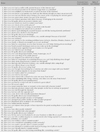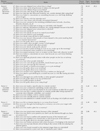Abstract
Methods
The process included construction of a conceptual framework, initial items, verification of content validity, selection of secondary items, and extraction of final items. The participants were 717 adolescents from six middle schools in three cities. Item analysis, factor analysis, criterion validity, and internal consistency were used to analyze the data.
Results
Fifty seven items were selected for the final scale, and categorized into 4 factors explaining 48.11% of total variance. The factors were labeled as latent problem behavior (38 items), suicidal behavior (7 items), runaways (3 items), and internet negative use (9 items). The scores for the scale were significantly correlated with crisis. Cronbach's alpha coefficient for the 57 items was .92.
Figures and Tables
References
1. Centers for Disease Control and Prevention. Youth risk behavior surveillance: United States, 2005. MMWR Morb Mortal Wkly Rep. 2006; 55(SS-5):1–112.
2. Cho YR, Lee HJ. A study on an model for internet addiction of adolescents. J Korean Acad Nurs. 2004; 34(3):541–551.

3. Chung HK, Kwon HJ. A forecast model on runaway youth. J Korean Acad Psychiatr Ment Health Nurs. 2001; 10(1):76–86.
4. Crawford TN, Cohen P, Midlarsky E, Brook JS. Internalizing symptoms in adolescents: Gender differences in vulnerability to parental distress and discord. J Res Adolesc. 2001; 11(1):95–118.

5. Eom HJ. Methodological comparisons between principal component and common factor model: Use, misuse, and abuse. Korean Soc Meas Eval Phys Edu Sports Sci. 2001; 3(1):101–130.
6. Guilamo-Ramos V, Litardo H, Jaccard J. Prevention programs for reducing adolescent problem behaviors: Implications of the co-occurrence of problem behaviors in adolescence. J Adolesc Health. 2009; 36(1):82–86.

7. Gullone E, Moore S, Moss S, Boyd C. The adolescent risk-taking questionnaire: Development and psychometric evaluation. J Adolesc Res. 2000; 15(2):231–250.
8. Han SC. Analysis of a prediction factor of risk behavior with adolescents at a small cities. Korean J Educ Psychol. 2004; 18(3):193–210.
9. Han SC. Adolescent's risk behavior and the quality of life: The role of protective factors on risk behavior. Korean J Psychol Soc Issues. 2006; 12(5):99–116.
10. Han SC. Exploration on risk and productive factors of adolescent runaway. Korean J Psychol Soc Issues. 2008; 14(1):273–298.
11. Hellandsjø Bu ET, Watten RG, Foxcroft DR, Ingebrigtsen JE, Relling G. Teenage alcohol and intoxication debut: The impact of family socialization factors, living area, and participation in organized sports. Alcohol Alcohol. 2002; 37:74–80.

12. Hwang YJ. Development of a self-worth program for the adolescents at risk. Daejon: Hannam University;2007. Unpublished master's thesis.
13. Jeon DH. The influence of depression and sensation seeking on risk behavior of adolescents. Kyung San: Kyung San University;2002. Unpublished master's thesis.
14. Jo JY, Kim YH. A path model of self, family, & extrafamilial system factors associated with adolescents sexual risk behaviors. J Korean Home Econ Assoc. 2006; 44(3):181–195.
15. Kim HL. Analysis of factors influencing risk behavior in middle school students. Seoul: Yonsei University;2008. Unpublished doctoral dissertation.
16. Kim JH. Youth health risk behavior survey in Korea. Seoul: Hanyang University;2004. Unpublished master's thesis.
17. Kim JY. A study of reliability and validity for the Korean version of youth risk behavior survey. Seoul: Yonsei University;2006. Unpublished master's thesis.
18. Kim KT. How mood affects message recall, intention, and attitude change among internet addicts. Seoul: Korea University;2009. Unpublished master's thesis.
19. Kim MS. Risk behavior of perspectives for lifestyle: Focus on reckless driving. Korean J Youth Stud. 2008; 15(1):1–325.
20. Kim SJ, Lee CS, Kweon YR, Oh MR, Kim BY. Test of validity and reliability of the adolescent mental problem questionnaire for Korean High School Students. J Korean Acad Nurs. 2009; 39:700–708.

21. Koo BY, Keum MJ. Development of the support model for crisis (possibly) youth. Seoul: Government Youth Commission;2005.
22. Kwon IS, Lee GE, Kim GD, Kim YH, Park KM, Park HS, et al. Development of a critical thinking disposing scale for nursing students. J Korean Acad Nurs. 2006; 36(6):950–958.

23. Lee HS, Kim Y. Korean SPSS 10.0 guide for the beginner. Seoul: Bubmoonsa;2002.
24. Lee JH, Kim KH, Choi MH, Kim HY, Oh GS, Kim KS. A study on gender-role identity and cyber delinquency in high-school students. J Korean Acad Psychiatr Ment Health Nurs. 2010; 19(1):76–84.

25. Lee JJ, Lee CW. Youth risk behavior survey of middle school students in Daegu metropolitan city. J Korean Soc Health Educ Promot. 2002; 19(3):51–72.
26. Lee MA. A study on adolescents' deviant behavior depending on school-environment factors. Daegu: Daegu University;2005. Unpublished master's thesis.
27. Michal LL, Ben-Zur H. Risk taking among adolescents: Association with social and affective factors. J Adolesc. 2007; 30:17–31.
28. Oh KJ, Ha UH, Lee H, Hong KE. K-YSR: Manual for the youth self-report. Seoul: Gungang-Jucsung Press;2001.
29. Yi SY. Mother's management strategy of peers relations, friendship quality, and problem behavior: The moderating effect of parental style. Seoul: Ewha Womans University;2009. Unpublished master's thesis.
30. Yoon HM, Nam YO. Factors associated with adolescents' risk-taking behaviors. J Korean Soc Child Welf. 2004; 23:127–153.




 PDF
PDF ePub
ePub Citation
Citation Print
Print






 XML Download
XML Download